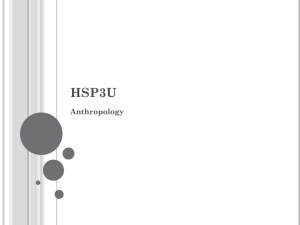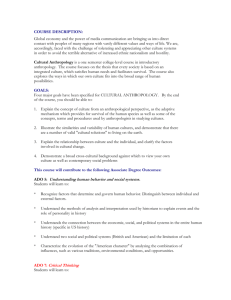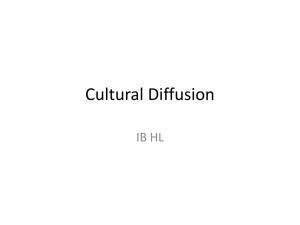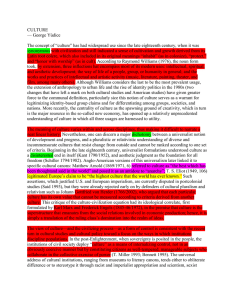1. Physical Anthropology
advertisement
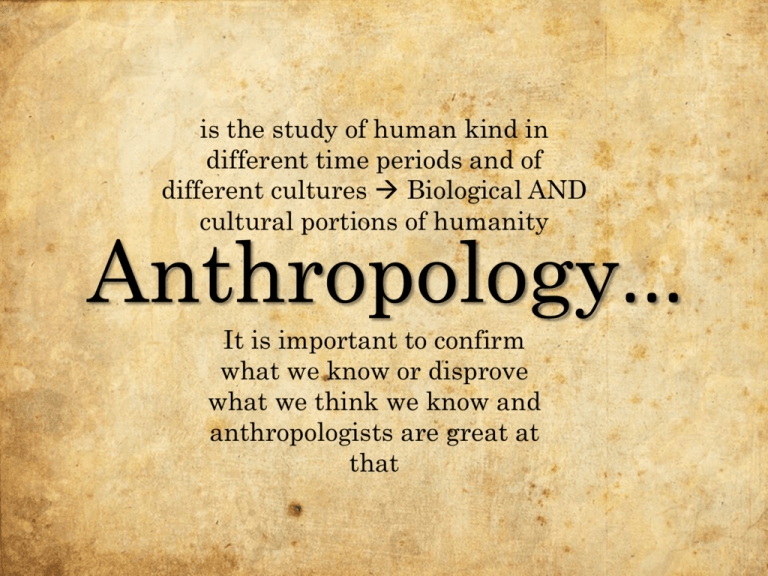
is the study of human kind in different time periods and of different cultures Biological AND cultural portions of humanity Anthropology... It is important to confirm what we know or disprove what we think we know and anthropologists are great at that The most effective way to view a culture is with Participant observation. Being an active observer is the least invasive way to collect data and facts about a culture and you are less likely to effect the culture or change it in any way. The 4 Inter-related parts of culture… Physical Environment Level of Technology System of Symbols Social Organization Social Change Sources of Change Methods of Adaption 1) Discovery: finding something that was unknown, changes beliefs/views on unknown facts 1) Diffusion: cultures BORROWING ideas/methods with each other (across the globe) 2) Invention: new ideas and products created based on the needs of society 3) Diffusion: the spreading/sharing of practices and methods between cultures 2) Acculturation: prolonged CONTACT between cultures results in interchanging ideas and methods (local) 3) Cultural Evolution: societies evolving according to predictable patterns Structuralism According to this view the world is scene in two different ways or as binary opposites i.e. black and white. This view shows society's good things and bad things like its ok to have a fire camping but not in the middle of a unvented living room Functionalism In this view all cultures are made to deal with universal problems that strike the world. Societies must have a set standard of laws and practices to provide stability. These would be referred to as social institutions. Cultural Materialism • Looks at cultural through development of economy and technology • Explores economic production • Assumes that laws fit equally to all societies and is considered biased four main subdivisions The Branch of anthropology that studies the physical development of the human species through biological evolution, genetic inheritance, human adaptability and variation, primatology, and the fossil record of human evolution The branch of anthropology focused on the study of cultural variation among humans. Such as Culture, ethnocentrism, cultural aspects of language and communication, subsistence and other economic patterns, kinship, sex and marriage, socialization, social control, political organization, class, ethnicity, gender, religion, and culture change The study of human activity in the past. It is Prehistory and early history of cultures around the world; major trends in cultural evolution; and techniques for finding, excavating, dating, and analyzing material remains of past societies. The study of how language influences social life. focusing on the importance of sociocultural influences; nonverbal communication; and the structure, function, and history of languages, dialects, pidgins, and creoles Their skills - Participant observation Collection of stats Field interviews Comp of detailed notes Ethnography 4 Main Subdivisions they disprove what we believe to be true, or vice versa Idea varies between cultures Defines marriage in 3 ways: mating (marriage), birth (descent), nurturance (adoption) Anthropologists discovered that to live in a culture as an active participant rather than simply an observer you gain the most knowledge – it is the best way to study Cultural: anything cultural Physical: related to evolution Archaeological: prehistory & remains Linguistic: languages Anthropology Study of humankind throughout the ages and around the world, looking biologically and culturally Schools of Thought Structuralism: attempts to see as a whole, social functions within institutions, sees cultures as more stable than they are Functionalism: sees based on common things in human mind, based on opposites, too heavy on logic overemphasizes the stability of cultures Cultural Materialism: sees through technology/economy, looks at individ.’s decisions w/ economy and reproduction, tries to apply laws to all cultures, sees through biased eyes Social Change Changes in social structure & institutions Sources of change Invention: new products & ideas Discovery: learn a previously unknown thing Diffusion: spreading of tools/ideas/etc. Culture: Four Inter-related Parts 1) 2) 3) 4) Physical Environment Level of Technology Social Organization System of Symbols Methods of Social Change Happens in 3 methods Diffusion: one culture borrows symbols form another Acculturation: prolonged contact Cultural Evolution: cultures evolve according to common patterns Kinship Why do we need anthropologists? To clarify things from our intuitions
